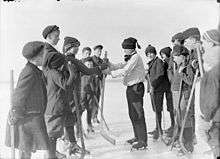Shinny
Shinny (also shinney, pick-up hockey, pond hockey, or "outdoor puck") is an informal type of hockey played on ice. It is also used as another term for street hockey. There are no formal rules or specific positions, and often, there are no goaltenders. The goal areas at each end may be marked by nets, or simply by objects, such as stones or blocks of snow. Body checking and lifting or "roofing/reefing/raising the puck" (shooting the puck or ball so it rises above the ice) are often forbidden because the players are not wearing protective equipment. Shinny is a game that all levels of hockey enthusiasts can play because it requires no rink, requires no skills except ability to hold a stick and at the very least to try to touch the puck or ball when it goes by. Shinny may be completely non-competitive and recreational.

In his book Country on Ice, Doug Beardsley claims that most Canadian hockey professional players have played some form of shinny in their youth.[1]
Team formation
There is a common ritual for choosing teams, which has each player "throwing" their hockey stick into a pile at centre ice, or the middle area between two nets. A player then divides the pile into two smaller piles, ostensibly at random, but perhaps strategically assigning sticks to one side or another. Players then pick up their own sticks, the teams having been formed.
Teams are often formed with intent to divide the group into approximately equal levels of skills among the players. Players joining after play has started are usually told "which way they are going" (which net they should shoot towards) based upon the score of the game and their skill level. Some games continue for many hours with a variety of players participating for as long as they want.
History and name origin
Shinny, generally believed to be a precursor to ice hockey, was informal enough in its formative years that the pucks and sticks were often makeshift. During the Great Depression, for example, northern boys used tree branches or broomhandles as sticks, a tin can, a piece of wood, and even a frozen road apple (horse dropping) as a puck. Any object about the right size might serve as a puck.
The name is derived from the Scottish game shinty and indeed shinny was a common name for one of shinty's many regional variations in Scotland. Shinny, a primarily Canadian term, is usually called "pick-up hockey" or "pond hockey" in the United States.[2]
Institutionalized usage
In some municipalities around the world where the climate permits, part of a city's taxes may go to the formal set-up and maintenance of skating rinks designed specifically for shinny. In some cities, such as Montreal; Quebec; and both Edmonton and Calgary, Alberta, Canada, numerous rinks are erected and are maintained by civil servants throughout the winter as long as the weather allows their usage to continue.
The city of Toronto hosts free or low-cost shinny sessions and also has programs for adults to learn how to shinny on city rinks. Toronto has more outdoor mechanically-cooled rinks than any city in the world, with 53 outdoor mechanically cooled rinks currently in operation.
The programs, expanded in 2011, include parent/child shinny and two levels of beginner, and are supervised by city-paid coaches.
References
- Beardlsey, Doug (1988). Country on Ice (PaperJacks ed.). Toronto: PaperJacks. ISBN 9780770110857.
- ShinnyUSA.com. Retrieved 16 December 2012.